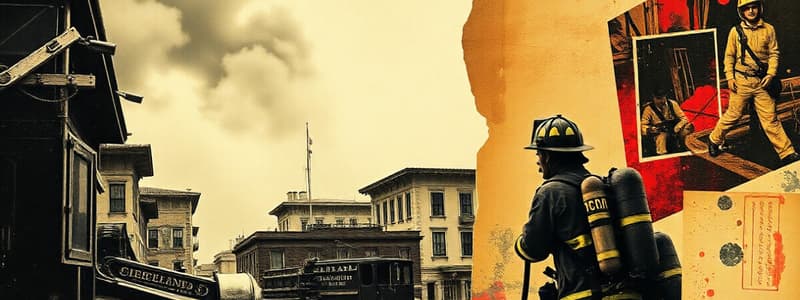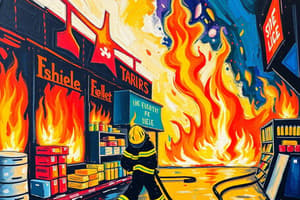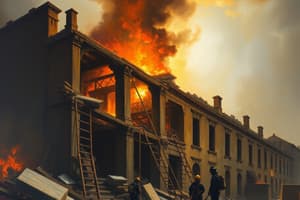Podcast
Questions and Answers
How has the average number of firefighter deaths changed since the 1970s?
How has the average number of firefighter deaths changed since the 1970s?
- Increased significantly
- Remained the same
- Decreased by more than 30% (correct)
- Doubled
What was the average number of firefighter deaths per year in the 1970s?
What was the average number of firefighter deaths per year in the 1970s?
- 150 (correct)
- 125
- 64
- 95
Which type of injury was most common among firefighters according to the NFPA report for 2012?
Which type of injury was most common among firefighters according to the NFPA report for 2012?
- Strains and sprains (correct)
- Burns
- Fractures
- Smoke inhalation
What is the first priority of firefighting?
What is the first priority of firefighting?
Which organization is responsible for conducting fatal firefighter investigations?
Which organization is responsible for conducting fatal firefighter investigations?
Which firefighting tactic presents a higher risk?
Which firefighting tactic presents a higher risk?
Why is operating above a fire considered dangerous?
Why is operating above a fire considered dangerous?
What significant change in firefighter safety is highlighted since World War II?
What significant change in firefighter safety is highlighted since World War II?
What does BLEVE stand for in the context of fire hazards?
What does BLEVE stand for in the context of fire hazards?
What percentage of firefighter deaths occur while responding to or returning from alarms?
What percentage of firefighter deaths occur while responding to or returning from alarms?
Which firefighting tactic is notably the second leading cause of firefighter deaths after structure fires?
Which firefighting tactic is notably the second leading cause of firefighter deaths after structure fires?
What makes advancing an attack hoseline a high-risk firefighting tactic?
What makes advancing an attack hoseline a high-risk firefighting tactic?
Which firefighting operation is most dangerous due to risks from roof collapses?
Which firefighting operation is most dangerous due to risks from roof collapses?
What is a major risk factor when operating above a fire?
What is a major risk factor when operating above a fire?
Why are cellar fires particularly treacherous for firefighters?
Why are cellar fires particularly treacherous for firefighters?
What hazard is linked to propane gas tank fires?
What hazard is linked to propane gas tank fires?
Why is outside venting classified as a dangerous firefighting tactic?
Why is outside venting classified as a dangerous firefighting tactic?
Which firefighting task is particularly hazardous due to the presence of corroded and deteriorated structures?
Which firefighting task is particularly hazardous due to the presence of corroded and deteriorated structures?
During overhauling operations, what type of injuries are most likely to occur?
During overhauling operations, what type of injuries are most likely to occur?
Which firefighting tactic is considered the most dangerous based on investigations?
Which firefighting tactic is considered the most dangerous based on investigations?
What action should firefighters avoid when operating a master stream?
What action should firefighters avoid when operating a master stream?
What increased risk is associated with firefighters using aerial ladders?
What increased risk is associated with firefighters using aerial ladders?
What hazards are prevalent during forcible entry operations?
What hazards are prevalent during forcible entry operations?
Why is it crucial for firefighters to know about past fatalities and injuries?
Why is it crucial for firefighters to know about past fatalities and injuries?
What factor is known to increase the danger of a firefighting tactic?
What factor is known to increase the danger of a firefighting tactic?
What makes operating in enclosed spaces like basements notably dangerous?
What makes operating in enclosed spaces like basements notably dangerous?
What makes early-stage firefighting more perilous than later stages?
What makes early-stage firefighting more perilous than later stages?
What is a common recurring cause of firefighter death and injury?
What is a common recurring cause of firefighter death and injury?
Flashcards are hidden until you start studying
Study Notes
Firefighter Deaths and Injuries
- Since the 1970s, average firefighter deaths have more than decreased 30%.
- In the 1970s, the average number of firefighter deaths per year was 150.
- In 2012, 64 firefighters lost their lives in the line of duty.
- Strains and sprains emerged as the most common injuries for firefighters in 2012.
Firefighting Priorities
- Protection of life is the foremost priority in firefighting operations.
- Significant advancements in firefighter safety have occurred due to OSHA and NFPA regulations since World War II.
Risk Evaluation and Safety Recommendations
- Investigations into firefighter fatalities are conducted by NIOSH, which also provides safety recommendations.
- Advancing a hoseline is identified as a higher-risk tactic compared to raising a ladder due to exposure to flame and heat.
Hazards and Risks of Firefighting Tactics
- Operating above a fire poses dangers such as heat and smoke obstructing escape routes.
- Rising flames create critical risks for firefighters working close to a fire's origin.
- A BLEVE (Boiling Liquid Expanding Vapor Explosion) can occur during propane gas tank fires.
Causes of Firefighter Deaths
- About 25% of firefighter deaths occur while responding or returning from alarms.
- Wildfires are the second leading cause of firefighter deaths after structure fires.
- Firefighters risk significant exposure when advancing an attack hoseline and facing direct flames.
Structural Risks
- Operating on peaked roofs can lead to falls or roof collapses.
- Fighting cellar fires is hazardous due to low visibility and challenging access paths.
- Dramatic hazards arise from corroded or deteriorating structures during firefighters' operations.
Common Tactics and Associated Dangers
- Outside venting exposes firefighters to potential falling debris and broken glass.
- Overhauling operations can lead to injuries from collapsing structures or smoke inhalation.
- Collapse rescue operations are deemed among the most dangerous according to NIOSH investigations.
Safety Practices
- Master streams should not direct water at parapet walls to avoid structural risks.
- The use of aerial ladders significantly increases the likelihood of falls from ladders or platforms.
- Forcible entry exposes firefighters to risks of flashovers, backdrafts, and explosions.
Awareness and Education
- Awareness of previous firefighter fatalities and injuries is crucial for improving survival rates.
- Operating in close proximity to flames raises the danger level of firefighting tactics significantly.
- Enclosed spaces, such as basements, are particularly dangerous due to ventilation and gas buildup concerns.
- Early-stage firefighting presents a higher risk of flashover and explosions compared to later stages.
Common Recurring Causes of Injuries
- A frequent cause of deaths and injuries includes being trapped in smoke-filled environments without access to a hoseline.
High-Risk Matrix
- The high-risk matrix serves to compare firefighting tactics based on their associated risk and frequency of occurrence.
Studying That Suits You
Use AI to generate personalized quizzes and flashcards to suit your learning preferences.




